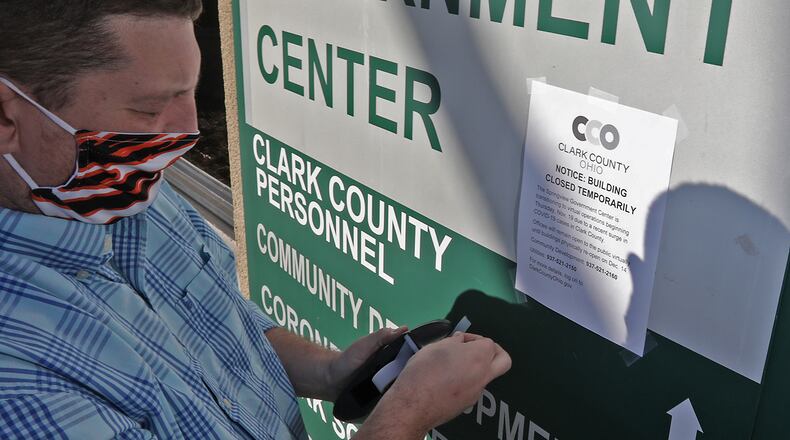According to the county, buildings physically re-open on Dec. 14. Offices will remain closed as planned on Nov. 26 and 27 for the Thanksgiving holiday.
“While buildings will be temporarily closed as a precautionary measure to ensure essential government services run efficiently, the agencies located inside those facilities will remain open and employees will report to work according to department policies,” a statement from the county said. “Residents are encouraged to do business online or by phone as much as possible during the next three weeks. Individuals may schedule appointments with departments as needed.”
Because of the shift to virtual operations, the commission will host its next three Wednesday meetings via Zoom. Details for those meetings will be posted on the county’s website.
The county closed several public buildings, including the Springview Government Center, Clark County Dog Shelter and Clark County Soliday Waste District, in March as a precautionary COVID-19 measure . Buildings began reopening at the beginning of May.
Dec. 14 is the Monday following Gov. Mike DeWine’s 21-day curfew, which is why the commission selected it as their return date, Commission President Melanie Flax Wilt said.
Clark County Combined Health District Commissioner Charles Patterson said he “can’t say enough good things,” about the county’s decision to move employees to remote work.
Patterson said the health district approached both the county and City of Springfield officials two weeks ago and suggested they return to a virtual format as a way to encourage other businesses in the county to do the same.
“It was not a mandate, it was just a request, but I think they really stepped up and I think they are really leading by example and showing the community how important it is to take this seriously,” Patterson said.
Valerie Lough, the Community Information Coordinator with the City of Springfield, said that the city does not have immediate plans to shift employees back to strictly remote work. She said that city commission meetings would as of Wednesday afternoon, still be conducted in-person but with limited attendance and social distancing guidelines.
Lough said that some city employees are still working remotely. However, she said the number of employees in the office depends on the department.
The statewide curfew, which is from 10 p.m. until 5 a.m., will continue for the next three weeks in an effort to help reduce the spread of the coronavirus.
It does not apply to people going to and from work, anyone getting groceries or picking up takeout, going to the hospital or picking up medicine. DeWine said violation of this curfew would be a second-degree misdemeanor but doesn’t anticipate police to pull people over after 10 p.m., but maybe talk to them if they’re outside hanging in groups.
Patterson said he believes the curfew “could” have a positive impact on slowing down cases in the county, but only if people follow it.
“It’s the same idea behind the mask mandate, it only works if people follow it and wear a mask," Patterson said. “People are going to have to understand the impact of this virus enough that they chose to adhere to those regulations. There isn’t going to be a coronavirus patrol out in the streets every night looking for people who violate the curfew. It’s up to the public.”
Clark County Sheriff’s Office Lt. Dustin White, who spoke to the commission on Wednesday about plans to enforce the curfew, said the responsibility does fall on the law enforcement, but the sheriff’s office hasn’t received any guidance from the state on what that means.
“Common sense has to prevail on this,” White said. “It has to be extreme for us to take action. We aren’t just going to be picking people up off the street and taking them to jail.”
Chief Lee Graf with the Springfield Police Division said that his department has also not received guidance and said that officers would not be stopping drivers that are on the roads during the curfew or actively looking for violations.
Instead, the police division would encourage residents to comply with the order. Graf said that enforcement would pertain to calls of people refusing to leave businesses or infringing on other’s rights to follow the curfew.
Gabe Jones, health commissioner at the Champaign Health District, said because case numbers have been “so significant as of late,” the health district is hopeful more people will become aware of the seriousness of the COVID-19 and enforce the curfew.
“Hopefully people do their part to prevent the spread and protect themselves, as well as their loved ones, and the community,” Jones said.
Ohio’s summary of updated coronavirus data was delayed on Wednesday. The state usually updates the Ohio Department of Health dashboard at 2 p.m. each day, however, by 5:30 p.m. they had not yet been updated. Instead, a note on ODH’s website read, “Today’s case number summary will be delayed.”
Clark County had 4,327 cases, 110 deaths and five probable deaths of the coronavirus on Tuesday, according to ODH.
Facts & Figures:
3: Weeks the county will continue with virtual operations and the curfew will be in effect
10 p.m.-5 a.m.: Hours of statewide curfew
Dec. 14: Date Clark County scheduled to return to in-person operations


